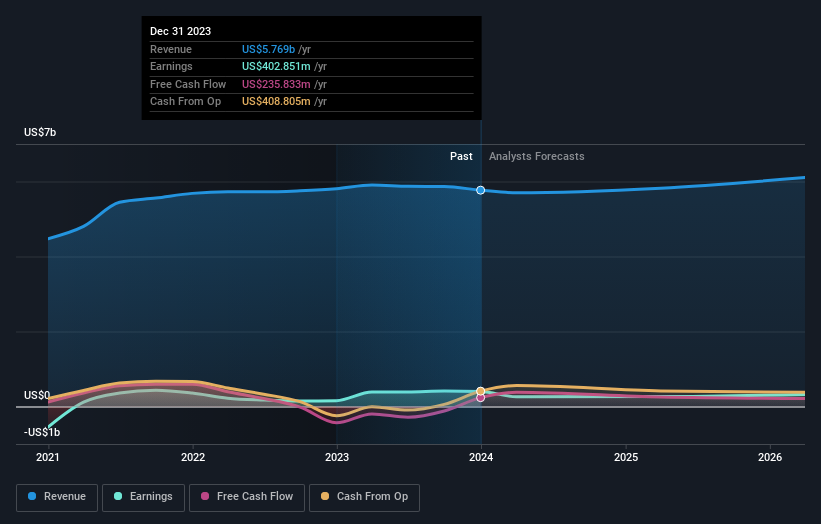Under Armour, Inc. (NYSE:UAA), might not be a large cap stock, but it saw significant share price movement during recent months on the NYSE, rising to highs of US$9.40 and falling to the lows of US$7.10. Some share price movements can give investors a better opportunity to enter into the stock, and potentially buy at a lower price. A question to answer is whether Under Armour's current trading price of US$7.10 reflective of the actual value of the mid-cap? Or is it currently undervalued, providing us with the opportunity to buy? Let’s take a look at Under Armour’s outlook and value based on the most recent financial data to see if there are any catalysts for a price change.
View our latest analysis for Under Armour
What Is Under Armour Worth?
The stock seems fairly valued at the moment according to our valuation model. It’s trading around 3.36% above our intrinsic value, which means if you buy Under Armour today, you’d be paying a relatively fair price for it. And if you believe the company’s true value is $6.87, there’s only an insignificant downside when the price falls to its real value. Is there another opportunity to buy low in the future? Since Under Armour’s share price is quite volatile, we could potentially see it sink lower (or rise higher) in the future, giving us another chance to buy. This is based on its high beta, which is a good indicator for how much the stock moves relative to the rest of the market.
What does the future of Under Armour look like?

Investors looking for growth in their portfolio may want to consider the prospects of a company before buying its shares. Buying a great company with a robust outlook at a cheap price is always a good investment, so let’s also take a look at the company's future expectations. However, with a negative profit growth of -13% expected over the next couple of years, near-term growth certainly doesn’t appear to be a driver for a buy decision for Under Armour. This certainty tips the risk-return scale towards higher risk.
What This Means For You
Are you a shareholder? UAA seems fairly priced right now, but given the uncertainty from negative returns in the future, this could be the right time to de-risk your portfolio. Is your current exposure to the stock optimal for your total portfolio? And is the opportunity cost of holding a negative-outlook stock too high? Before you make a decision on the stock, take a look at whether its fundamentals have changed.
Are you a potential investor? If you’ve been keeping tabs on UAA for a while, now may not be the most advantageous time to buy, given it is trading around its fair value. The price seems to be trading at fair value, which means there’s less benefit from mispricing. In addition to this, the negative growth outlook increases the risk of holding the stock. However, there are also other important factors we haven’t considered today, which can help crystalize your views on UAA should the price fluctuate below its true value.
It can be quite valuable to consider what analysts expect for Under Armour from their most recent forecasts. At Simply Wall St, we have the analysts estimates which you can view by clicking here.
If you are no longer interested in Under Armour, you can use our free platform to see our list of over 50 other stocks with a high growth potential.
New: AI Stock Screener & Alerts
Our new AI Stock Screener scans the market every day to uncover opportunities.
• Dividend Powerhouses (3%+ Yield)
• Undervalued Small Caps with Insider Buying
• High growth Tech and AI Companies
Or build your own from over 50 metrics.
Have feedback on this article? Concerned about the content? Get in touch with us directly. Alternatively, email editorial-team (at) simplywallst.com.
This article by Simply Wall St is general in nature. We provide commentary based on historical data and analyst forecasts only using an unbiased methodology and our articles are not intended to be financial advice. It does not constitute a recommendation to buy or sell any stock, and does not take account of your objectives, or your financial situation. We aim to bring you long-term focused analysis driven by fundamental data. Note that our analysis may not factor in the latest price-sensitive company announcements or qualitative material. Simply Wall St has no position in any stocks mentioned.
About NYSE:UAA
Under Armour
Engages developing, marketing, and distributing performance apparel, footwear, and accessories for men, women, and youth.
Adequate balance sheet and fair value.
Similar Companies
Market Insights
Community Narratives



